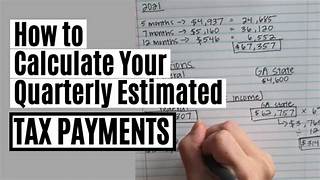How to Figure Out the Estimated Tax on Company Earnings
Introduction
Tax planning is an essential aspect of financial management for any business. Companies must calculate their estimated tax liability to comply with tax laws and avoid penalties. This article provides an in-depth guide on how to determine estimated taxes on company earnings, covering the types of taxes businesses owe, key calculation methods, and best practices for accurate tax planning.
1. Understanding Estimated Taxes
Estimated tax is a periodic payment made by businesses to cover income tax, self-employment tax, and other obligations. Companies must pay estimated taxes if they expect to owe $500 or more in federal income tax for the year.
2. Types of Taxes Companies Must Pay
Businesses are subject to various taxes, including:
- Corporate Income Tax: Applies to C corporations at a federal rate of 21% (as of 2024) and additional state taxes.
- Self-Employment Tax: Covers Social Security and Medicare for sole proprietors and partners.
- Payroll Taxes: Includes Social Security, Medicare, and federal unemployment taxes.
- Sales Tax: Applies to businesses selling goods and certain services, varying by state.
- Excise Taxes: Imposed on specific goods like fuel, alcohol, and tobacco.
3. How to Estimate Business Taxes
To estimate tax liability, companies typically follow these steps:
Step 1: Determine Taxable Income
Taxable income is calculated as: Total Revenue−Allowable Deductions=Taxable Income\text{Total Revenue} – \text{Allowable Deductions} = \text{Taxable Income} Allowable deductions include business expenses such as rent, salaries, utilities, and depreciation.
Step 2: Apply the Appropriate Tax Rate
Different business structures have different tax rates:
- C Corporations: Taxed at a flat 21% rate.
- S Corporations and Partnerships: Pass-through entities where income is taxed at the owner’s individual tax rate.
- Sole Proprietorships: Income is reported on the owner’s personal tax return and taxed accordingly.
Step 3: Factor in Self-Employment Taxes (If Applicable)
Self-employed business owners must pay:
- Social Security tax: 12.4% (on earnings up to $168,600 in 2024)
- Medicare tax: 2.9% (with an additional 0.9% for income above $200,000)
Step 4: Account for Credits and Deductions
Businesses can reduce tax liability by claiming:
- Tax Credits: R&D tax credit, work opportunity tax credit, and energy-efficient incentives.
- Deductions: Depreciation, home office expenses, and health insurance costs.
Step 5: Divide the Total Tax by Four for Quarterly Payments
To comply with IRS regulations, estimated tax payments must be made quarterly:
- April 15 (Q1)
- June 15 (Q2)
- September 15 (Q3)
- January 15 of the following year (Q4)
4. Tools for Estimating Taxes
Businesses can use various tools to streamline tax calculations:
- IRS Form 1120-W: Helps C corporations estimate taxes.
- Tax Software: QuickBooks, TurboTax, and H&R Block simplify tax planning.
- Professional Accountants: Ensure accuracy and compliance with tax laws.
5. Consequences of Underpayment or Overpayment
- Underpayment: Companies may incur IRS penalties and interest.
- Overpayment: Leads to reduced cash flow, though excess payments can be refunded.
6. Best Practices for Accurate Tax Planning
- Keep accurate financial records.
- Review tax laws regularly for updates.
- Set aside funds for tax payments.
- Work with a tax professional for complex tax matters.
Conclusion
Estimating business taxes accurately is essential for financial stability and regulatory compliance. By understanding tax obligations, using proper calculation methods, and leveraging tax-saving opportunities, businesses can effectively manage their tax liabilities and avoid penalties. Implementing best practices ensures smooth tax planning and long-term success.


